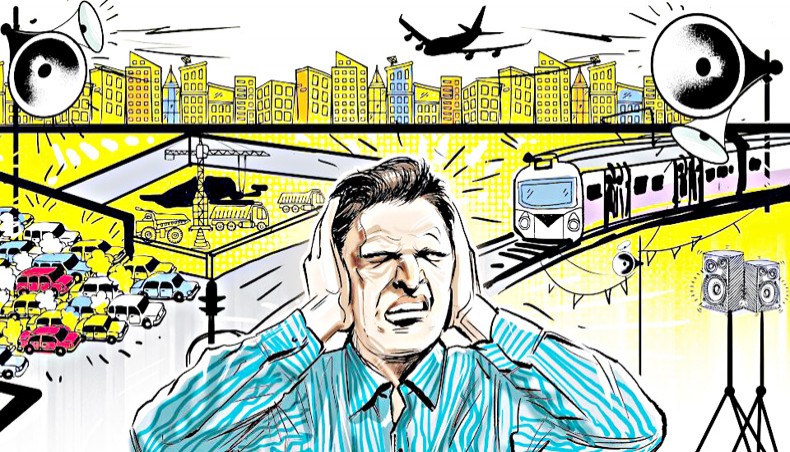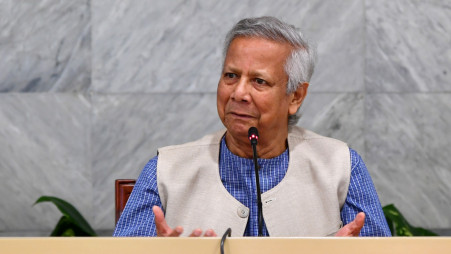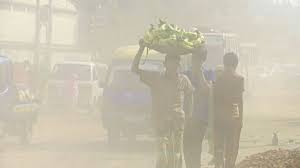IN THE city of Dhaka, it is often seen that cars and bikes are speeding along the empty streets with loud honking. Many drivers are honking even when the road is almost empty. The trend of indiscriminate honking is increasing day by day at an alarming rate. The attitude of many drivers seems to be that just honking will solve everything.
Noise pollution is increasing in other urban areas of Bangladesh. Lately, noise pollution is becoming a concern in rural and remote areas due to use of loud microphone for advertisement or in social events. Noise pollution, as it has not been resolved for years, is becoming a public health concern.
The alarming situation of noise pollution is also a cause of embarrassment for Bangladesh in the global context. Dhaka city has been ranked as one of the worst in terms of air pollution in 2022. Now it is also ranked the worst for noise pollution. A report of the United Nations Environment Programme titled ‘Frontiers 2022: Noise, Blazes and Mismatches’ on noise pollution provides detailed information on how noise pollution is affecting people’s physical and mental health.
According to the report, three of the world’s top five cities in noise pollution are located in South Asia. In terms of noise pollution, Moradabad in India’s Uttar Pradesh and Islamabad in Pakistan have occupied the second and third places after Dhaka. Rajshahi, another city of Bangladesh, ranks fourth and in the fifth position is Ho Chi Minh City of Vietnam.
According to the guidelines of the World Health Organisation, the acceptable level of indoor noise for humans is 55 decibels and 70 decibels for outdoor commercial areas. However, this level is 119 decibels in Dhaka and 103 decibels in Rajshahi. Major sources of noise pollution include noise emitted by vehicles during road traffic, aircraft, trains, industries and recreational activities. If these sounds are more than the standard, it endangers the physical and mental health of people.
In fact, the high-pitched horns or such levels of noise pollution are nothing new in cities including the capital. The longstanding problem has now taken explosive form. The noise emitted by city vehicles, vehicle horns, mics, loud speakers, brick and stone breakers, generators etc has reached unbearable levels.
Although there are various rules and regulations to control noise pollution, they are not being enforced. The hydraulic horns are banned to prevent physical and mental harm, but vehicle owners and drivers are largely non-compliant. Law forbids people from honking in front of the school or hospital, but people never oblige.
In a research at 48 points in Dhaka city, the sound level was found above 80 decibels at 15 points from 9 am to 7 pm, 10 points have sound level between 71 and 80 decibels, 13 spots have 61 to 70 decibels, 9 points have 51 to 60 decibels and 1 point has sound level between 45 and 50 decibels. The research shows that only 10 points have acceptable noise levels.
The survey result clearly depicts the alarming picture because acceptable sound levels, according to the WHO, are 25 decibels in residential homes and bedrooms, 40 decibels in other rooms, 20 to 30 decibels in hospitals, 40 to 50 decibels in restaurants, 35 to 40 decibels in office rooms, and 30 to 40 decibels in classrooms. According to Bangladesh Environment Movement, 30 serious diseases are caused by 12 types of environmental pollution and noise pollution is among them. Scientific researches suggest sound levels of 85 decibels or more are harmful to the human body.
According to an article published by the Australian Academy of Sciences, a person’s hearing can be seriously damaged, if they remain surrounded by loud noises. Loud noise also disturbs people’s sleep. It can cause heart disease, high blood pressure, heart palpitations, irritable mood, headaches, peptic ulcers, restlessness, inattention, sleep disturbances, hearing loss and normal performance. According to physicians, excessive noise pollution causes liver cirrhosis, gastric, diabetes, heart disease, hypertension, headache, irritability, loss of attention and various physical and mental damage.
A sudden loud noise can cause the eardrum to burst and bleed. Loud noise can cause inflammation in the ear and effusion. Prolonged exposure to loud noise sources can permanently damage a person’s hearing. Noise pollution causes serious harm to patients, pregnant women and children. Defective children can also be born due to noise pollution. Many animals are also disappearing from the city due to high noise pollution. The city is nearly birdless today.
Although noise pollution regulations of 2006 have been formulated to prevent noise pollution, sadly it only exists on paper. According to the rules, honking, use of mic in front of hospitals, educational institutions, places of worship and residential areas as well as creating loud noise in the name of social and religious functions are punishable offenses by law. Besides, the Environment and Forest Conservation Act, 1977 requires authorities to maintain a quiet zone up to 100 meters from hospitals, educational institutions and designated establishments and institutions.
In reality, there is no enforcement of the law. Lack of enforcement of laws is named as the main reason behind the acute problem of noise pollution in Bangladesh. In order to control and contain noise pollution, it is essential for everyone to play their part, but the concerned departments of the government also need to play their role to ensure strict enforcement of the law. By all means, we must contain the silent killer that is noise pollution.












